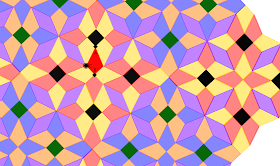Lots of pictures of quilts!
I see this as just #mathart appreciation, but also can be some inspiration for lessons. In fact,
#MTMSchat this month (August 17th, Wed, 9 pm ET) is on this
math and quilt article: Quilt Block Symmetries by Matt Roscoe and Joe Zephyrs.
Every year for our local Coast Guard Festival, the local quilting guild puts on a show. Elizabeth,
quilting friend and queen, usually gives us the insider's tour. I didn't take a picture of every beautiful thing, but did get most of the math that caught my eye. First up, the fractal quilt about which I have
that whole blogpost and GeoGebra.
Lots of interesting design choices from Elizabeth here in addition to the neat pattern. Some of the squares even have lissajous quilting.


Of course, hexagon tessellation, but there's also a permutation aspect to this one. With the center the same color, how many fabrics do you need to make 81 different hexes? This would also be nice to do some edge identification for a toroidal quilt!


Apologies: forgot to get separate shots of the labels for these, two.
On the left (Whirligig by Marcia Knorr), I love all the different quilting designs in the same quilt. I was wondering if they were organized, or what classes you might use to sort them. Kind of a giant which one doesn't belong.
On the right, I love the creation of near circles overlapping, with the decahexagons. Also some nice positive/negative space. Really this is made with just square tiles (2 sizes) and 2 kinds of triangles!


The design here is really special. The small scale rhombus tessellation underlies using color to get the effect of rhombs of different scale overlapping periodically. What are the scale factors linking these different sizes?


I don't know if any of you have this problem, but I am an obsessive counter. This has a large number of balloons in groups of 3 and 9. Each balloon is distinct, and each group of nine is arranged differently! But I disagree with Mrs. Johnson's count. (There were no balloons on the back.)

There are designs that people learn from a teacher or that are bought and sold. These are classic op art, but the deformations are interesting to look at, as well as these three variations.


Another by Elizabeth. Amazing to me how the overlapping of two similar patterns creates a third repeating shape of a white T. This one is for her daughter Honore.


Another nice use of negative space to emphasize the pattern, and interesting choices about the size of the circle relative to squares.

Here are my quilt show compatriots, Debbie, Karen (mí esposa), and Filiz. The discussion about the quilts, and the different levels of expertise is a lot of what makes the show so fun. Debbie is an experienced quilter as well.
Pretty neat symmetry variations here, also feeling like a #WODB.


Made me think I have not thought about the tiling possibilities of right trapezoids enough.



These trapezoids are arranged to almost make a hexagonal spiral. The irregularity is the part of the charm of the quilt to me, and I like the comparison with the concentric circle quilting.


Another case of two simple patterns over-lapping to make a much more complex design.


This reminded me of
quarter cross, and I like the effect of dividing up the squares into squares or triangles and alternating them. I can't tell if there's a pattern to the color choices, but I think there might be.

At the Tessellation Nation session at TMC16 (best coverage:
Joe Schwartz) I got interested in these nonperiodic tessellations with rotational symmetry, so I liked this immediately, and THEN I noticed the SPIRAL. Immediate mathquilt crush. I also like the "making it your own" aspect.


Sometimes quilters exchange work, with restrictions imposed. In this exchange, the original square had to be moved off center by the later additions. The idea of riffing on someone else's design/math is something I'd like to bring into my classes.


Attendees were fascinated by the 3-D and labyrinth aspect of this quilt.
The description of making this is what sold me here. A square is cut along the diagonal. A quarter inch border is sewn together with a 1 inch strip of fabric to make one bar of the X, making a half inch diagonal, and then the process is repeated for the other bar, resulting in a square of the same dimensions!

Elizabeth herself, with a quilt she liked. She likes spiky designs, and thought the use of 3/4 circles was interesting and placed interestingly.



Two neat tessellations, both playing with positive and negative space.
How many equivalence classes of squares in this quilt?
This next quilt is another one interesting for the process. All the different squares are from the same fabric!

Last one: A year or so ago Elizabeth asked if it was possible to have a round robin for six people where each person worked on each quilt once, but on each exchange you received your quilt from someone new. I talked out the problem with my colleague Brian Drake, and it's now a problem in our discrete course. Hint: yes. I was doing it the same time my capstone students got absorbed in magic squares and there are great connections. Here are the round robin quilts. (My
solution for six.)
Bonus material: I'm loving
the quilting blog that Elizabeth recommended. Maybe start
here or
here if you're interested.

































































